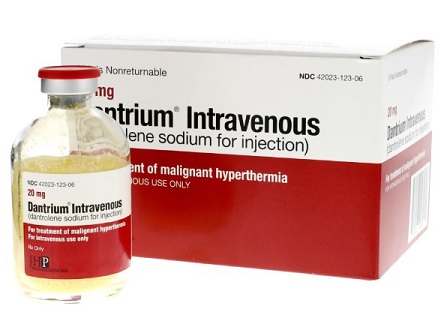Dantrolene Exhibits Neuroprotective Properties In Various Neurodegenerative Diseases
Nikhil Prasad Fact checked by:Thailand Medical News Team May 01, 2024 1 year, 7 months, 2 weeks, 3 days, 15 hours, 30 minutes ago
Medical News: Neurodegenerative diseases (NDs) pose a significant challenge in modern medicine, characterized by progressive cell death in the nervous system leading to cognitive or motor dysfunction. While treatments for NDs often focus on symptom management, there's a growing interest in exploring disease-modifying drugs. One such drug, dantrolene, originally approved for conditions like malignant hyperthermia, has shown promise in neuroprotection across various NDs. This
Medical News report delves into the recent findings from the University of Pennsylvania regarding dantrolene's neuroprotective properties, its pharmacology, therapeutic uses, adverse effects, and its potential as a treatment for NDs.
 Dantrolene Exhibits Neuroprotective Properties In Various Neurodegenerative Diseases
Understanding Neurodegenerative Diseases
Dantrolene Exhibits Neuroprotective Properties In Various Neurodegenerative Diseases
Understanding Neurodegenerative Diseases
NDs encompass a spectrum of conditions including Alzheimer's disease (AD), Parkinson's disease (PD), Huntington's disease (HD), amyotrophic lateral sclerosis (ALS), and multiple sclerosis (MS). These diseases result in debilitating symptoms and are often incurable. Current treatments focus on symptom management, highlighting the need for disease-modifying therapies.
Dantrolene: Mechanisms and Pharmacology
Initially approved for malignant hyperthermia, dantrolene acts as a ryanodine receptor (RyR) antagonist, regulating calcium release from intracellular stores. Its pharmacokinetics, chemistry, and therapeutic formulations have evolved, including new intravenous formulations like Ryanodex. Dantrolene's mechanism of action primarily involves stabilizing calcium levels, crucial in conditions where calcium dysregulation contributes to pathogenesis.
Therapeutic Applications of Dantrolene
Beyond its original indications, dantrolene finds use in treating muscle spasms, neuroleptic malignant syndrome, ecstasy intoxication, and exertional heat stroke. Its effectiveness in these conditions stems from its ability to modulate calcium levels, thereby reducing muscle hyperactivity and associated symptoms.
Adverse Effects and Safety Profile
Like any medication, dantrolene carries potential adverse effects, including muscle weakness, phlebitis, and respiratory issues. Long-term oral use may also impact liver function. However, its safety profile is generally favorable when administered appropriately.
Neuroprotective Mechanisms of Dantrolene
Recent studies, including those from the University of Pennsylvania, highlight dantrolene's neuroprotective effects. These effects are attributed to its ability to mitigate excitotoxicity, apoptosis, and neuroinflammation, processes central to ND pathogenesis
Elucidating Dantrolene's Mechanisms
Dantrolene's neuroprotective mechanisms involve modulating intracellular calcium
dynamics. By inhibiting aberrant calcium release from intracellular stores like the endoplasmic reticulum (ER), dantrolene reduces excitotoxicity, apoptosis, and neuroinflammation, key drivers of neuronal damage in NDs.
-Calcium Dysregulation and Neurodegeneration
In neurodegenerative diseases (NDs), calcium dysregulation plays a pivotal role in neuronal damage. Normally, calcium ions (Ca2+) are vital signaling molecules involved in numerous cellular processes. However, excessive or dysregulated calcium influx, particularly from intracellular stores like the endoplasmic reticulum (ER), can trigger detrimental cascades leading to neuronal dysfunction and death. This phenomenon, known as excitotoxicity, is a hallmark feature in conditions such as Alzheimer's disease (AD), Parkinson's disease (PD), and Huntington's disease (HD).
-Dantrolene's Role in Calcium Homeostasis
Dantrolene exerts its neuroprotective effects by modulating intracellular calcium dynamics. As a ryanodine receptor (RyR) antagonist, dantrolene blocks excessive calcium release from the ER, thereby mitigating excitotoxicity. RyRs are calcium channels crucial for cellular calcium signaling, and their dysregulation contributes to neuronal damage in NDs.
-Excitotoxicity and Cell Death
Excitotoxicity refers to the toxic effects of excessive glutamate, an excitatory neurotransmitter, on neurons. In conditions like AD and HD, aberrant glutamate signaling leads to calcium influx, mitochondrial dysfunction, and ultimately, neuronal death. Dantrolene's ability to reduce excitotoxicity by regulating calcium release helps protect neurons from this destructive process.
-Apoptosis Pathways
Apart from excitotoxicity, apoptosis (programmed cell death) is another pathway implicated in ND pathogenesis. Calcium dysregulation can activate apoptotic pathways, leading to neuronal loss. Dantrolene has been shown to attenuate apoptosis by stabilizing calcium levels and preventing the activation of pro-apoptotic signaling cascades, thereby promoting neuronal survival.
-Neuroinflammation and Dantrolene
Neuroinflammation is a prominent feature in many NDs and contributes to disease progression. Excessive calcium signaling can trigger inflammatory responses in glial cells, leading to the release of pro-inflammatory cytokines and oxidative stress. Dantrolene's ability to modulate calcium levels reduces neuroinflammation by inhibiting microglial activation and cytokine production, thus preserving neuronal integrity.
-Emerging Insights: Autophagy and Synaptic Plasticity
Recent research has unveiled additional neuroprotective mechanisms of dantrolene, including its impact on autophagy and synaptic plasticity. Autophagy is a cellular process that clears damaged proteins and organelles, crucial for neuronal health. Dantrolene enhances autophagic clearance, reducing the buildup of toxic protein aggregates seen in NDs. Furthermore, dantrolene preserves synaptic plasticity, crucial for maintaining neuronal communication and function.
Potential Clinical Implications
Understanding dantrolene's multifaceted neuroprotective mechanisms holds promise for developing targeted therapies in NDs. By addressing calcium dysregulation, excitotoxicity, apoptosis, and neuroinflammation, dantrolene offers a comprehensive approach to preserving neuronal health and function. Continued research into its precise mechanisms and clinical efficacy will pave the way for personalized treatments and improved outcomes in ND patients.
Exciting Research in Alzheimer's Disease and Huntington's Disease
Studies in murine models of AD and HD demonstrate dantrolene's potential in reducing amyloid accumulation, tau phosphorylation, and neuronal loss. Furthermore, dantrolene shows promise in restoring autophagic clearance, preserving synaptic plasticity, and improving cognitive function in these models.
Future Perspectives and Implications
The findings from the University of Pennsylvania and other research institutions underscore dantrolene's potential as a disease-modifying therapy for NDs. Further investigations into its mechanisms and clinical efficacy are warranted, paving the way for personalized treatment strategies and improved outcomes in these challenging neurological conditions.
Conclusion
In conclusion, dantrolene emerges as a promising candidate for neuroprotection in NDs. Its established safety profile, coupled with its ability to modulate calcium-mediated pathways implicated in ND pathogenesis, positions it as a potential disease-modifying agent. Collaborative research efforts, as exemplified by the study, are crucial in unraveling dantrolene's full therapeutic potential and bringing us closer to effective treatments for NDs.
The study findings were published in the peer reviewed Journal of Anesthesia and Translational Medicine.
https://www.sciencedirect.com/science/article/pii/S2957391224000573
For the latest about Neurodegenerative Diseases, keep on logging to Thailand
Medical News.
